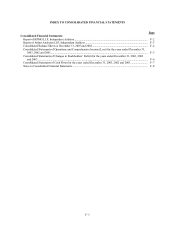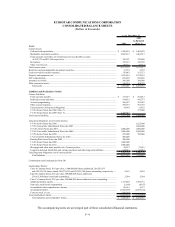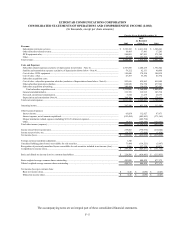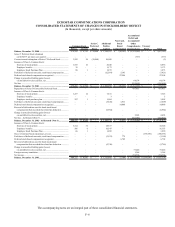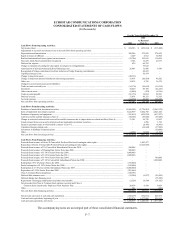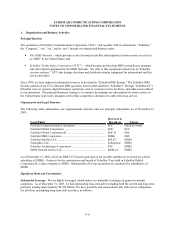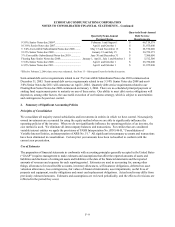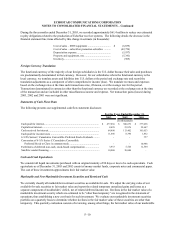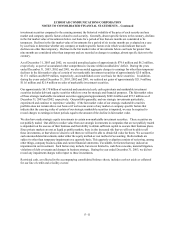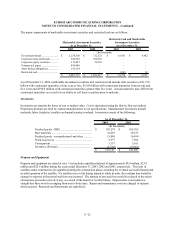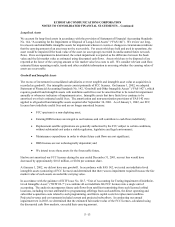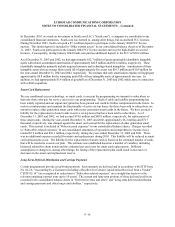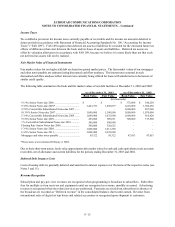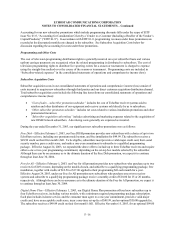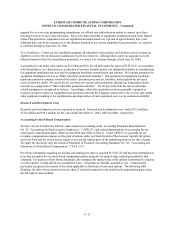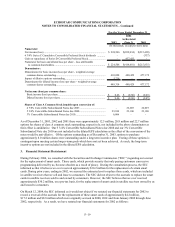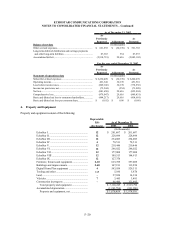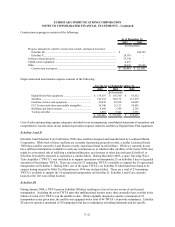Dish Network 2003 Annual Report Download - page 78
Download and view the complete annual report
Please find page 78 of the 2003 Dish Network annual report below. You can navigate through the pages in the report by either clicking on the pages listed below, or by using the keyword search tool below to find specific information within the annual report.ECHOSTAR COMMUNICATIONS CORPORATION
NOTES TO CONSOLIDATED FINANCIAL STATEMENTS – Continued
F–11
investment securities compared to the carrying amount, the historical volatility of the price of each security and any
market and company specific factors related to each security. Generally, absent specific factors to the contrary, declines
in the fair market value of investments below cost basis for a period of less than six months are considered to be
temporary. Declines in the fair market value of investments for a period of six to nine months are evaluated on a case
by case basis to determine whether any company or market-specific factors exist which would indicate that such
declines are other than temporary. Declines in the fair market value of investments below cost basis for greater than
nine months are considered other than temporary and are recorded as charges to earnings, absent specific factors to the
contrary.
As of December 31, 2003 and 2002, we recorded unrealized gains of approximately $79.6 million and $6.2 million,
respectively, as part of accumulated other comprehensive income within stockholders’ deficit. During the years
ended December 31, 2003, 2002 and 2001, we also recorded aggregate charges to earnings for other than temporary
declines in the fair market value of certain of our marketable investment securities of approximately $2.0 million,
$117.1 million and $69.9 million, respectively, and established a new cost basis for these securities. In addition,
during the years ended December 31, 2003, 2002 and 2001, we realized net gains of approximately $21.9 million,
$11.6 million and $21.4 million on sales of marketable investment securities.
Our approximately $4.170 billion of restricted and unrestricted cash, cash equivalents and marketable investment
securities includes debt and equity securities which we own for strategic and financial purposes. The fair market value
of these strategic marketable investment securities aggregated approximately $249.4 million and $72.5 million as of
December 31, 2003 and 2002, respectively. Our portfolio generally, and our strategic investments particularly,
experienced and continue to experience volatility. If the fair market value of our strategic marketable securities
portfolio does not remain above cost basis or if we become aware of any market or company specific factors that
indicate that the carrying value of certain of our strategic marketable securities is impaired, we may be required to
record charges to earnings in future periods equal to the amount of the decline in fair market value.
We also have made strategic equity investments in certain non-marketable investment securities. These securities are
not publicly traded. Our ability to realize value from our strategic investments in companies that are not publicly traded
is dependent on the success of their business and their ability to obtain sufficient capital to execute their business plans.
Since private markets are not as liquid as public markets, there is also increased risk that we will not be able to sell
these investments, or that when we desire to sell them we will not be able to obtain full value for them. We account for
such unconsolidated investments under either the equity method or cost method of accounting. Both methods are
subject to other than temporary impairment on a quarterly basis. This quarterly evaluation consists of reviewing, among
other things, company business plans and current financial statements, if available, for factors that may indicate an
impairment in our investment. Such factors may include, but are not limited to, cash flow concerns, material litigation,
violations of debt covenants and changes in business strategy. During the year ended December 31, 2003, we did not
record any impairment charges with respect to these investments.
Restricted cash, as reflected in the accompanying consolidated balance sheets, includes cash set aside as collateral
for our line of credit and a facility escrow.


